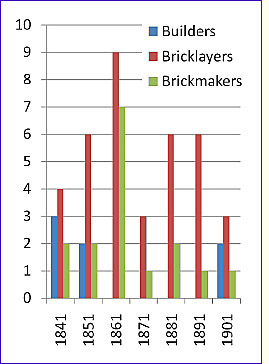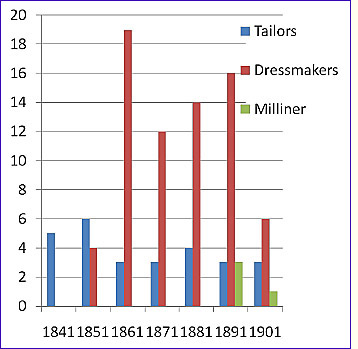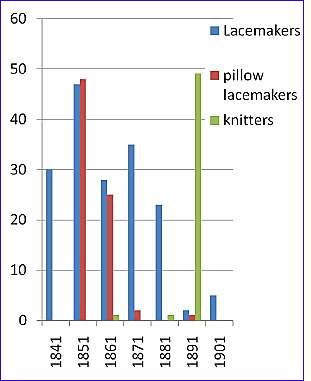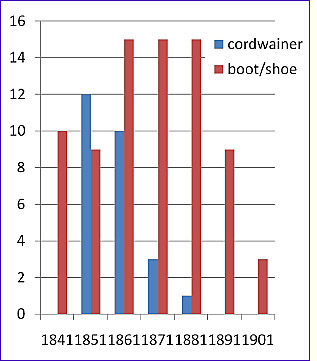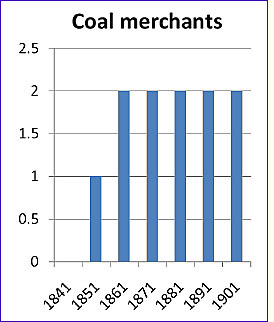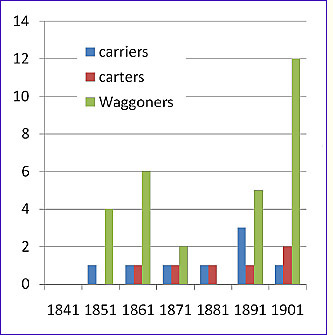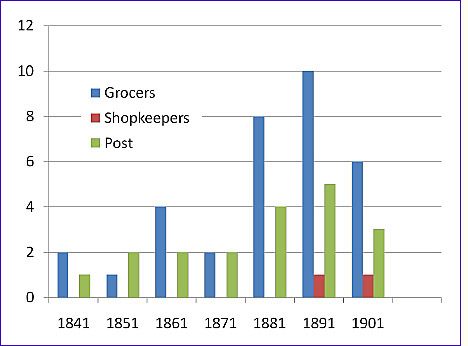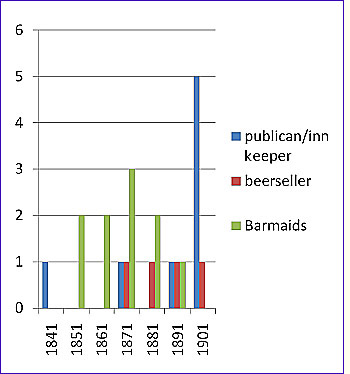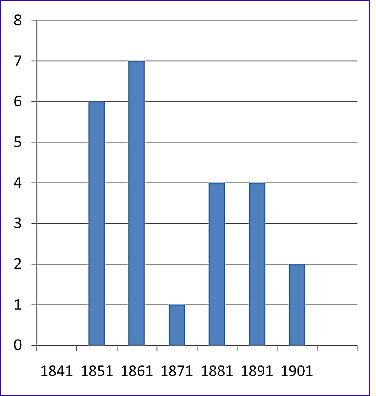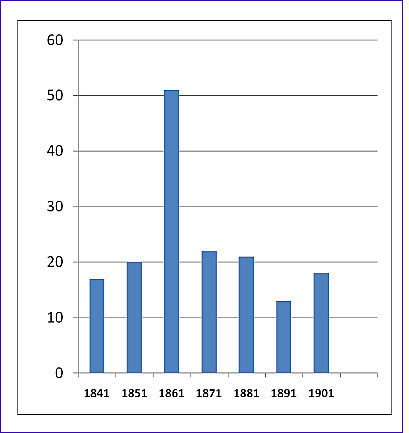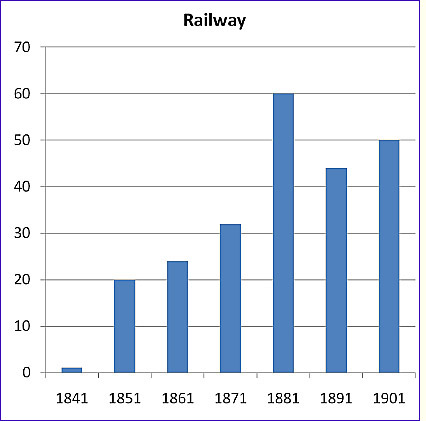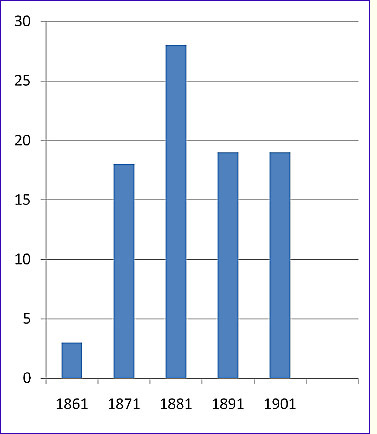|
Blisworth and its People 1841 - 1901, Part I Changing Patterns of Employment in the Victorian Period Authors: H. Spurrier, B. Andrews
and R. Freeston This is the product of meticulous work that began with Robin Freeston collecting data into MS XL charts from the UK census records between 1841 and 1901. All three authors then formulated a way in which the data would be best presented and Robin created the charts that were used in a MS Powerpoint presentation given by Hilary Spurrier and Beryl Andrews to a Friday meeting of the Heritage Society. The charts were later edited by Tony Marsh so that they could be incorporated more easily into a web-page. As first posted on this website in May 2013, the document had notes alongside most charts which corresponded with the 'bullet points' used in the presentation. As time goes by (we may expect months to elapse) the textual content will be enhanced according to inputs from the authors. Hypertext links may appear also.
Farming was central to Blisworth in the 19th Century and very labour intensive. The impact of mechanisation was only felt late in the century. The agricultural depression of the 1880s did not affect employment in Blisworth. Originally there were 7 farm houses in the centre of the village but after inclosure was completed in 1815, there were 5 new farm houses built on the periphery, surrounded by their new lands – Hill Farm, Lodge Farm, Tunnel Hill Farm, Blisworth Hill Farm and Glebe Farm. The Duke provided the allotment field in Stoke Road for use by the villagers.
The population of 600 – 700 at the start of the century rose to over 1000 in 1861 & 1881 (now about 2000). The number of households rose from 76 in mid C18 to 175 by 1841 mainly by large cottages and old farmhouses being divided to accommodate the rising population. New buildings included the Railway Cottages in 1840s, Westley’s Buildings in Stoke Road in 1850s, followed by the Coop grocery store (later Young's), a few cottages to Grafton design in the High Street, Courteenhall Road, Stoke Road, and Chapel Lane and in 1890s the terrace by the Sun Moon & Stars with 4 cottages at the rear. All were freehold except the Grafton cottages.
The 1851 peak reflects a peak in pig dealing - pork was a staple food as it could be cured for bacon and ham requiring only cool storage conditions. Few houses had their own oven and so used the village bake-houses. Butchers; 2 Northampton Road - Lepper family, Thackstone Cottage - Gibbs family followed by the Perkins, 46 High Street (demolished 1897) - Gibbs then George Cox, Sun Moon & Stars - Chester family 1861 – 1891 Bakehouses; Westleys mill & bakehouse, Stoke Road – the bakehouse continued after the fire, Thomas Sturgess baker in 1901, 38 High St (Old Bakehouse) – C17 thatched bakehouse at rear (closed in 1918), Goode family since 1740, then 1861 William Birch.
Brief notes: The rise in the later part of the century reflects the development of Westley's mill. This mill is said to have employed 45 people; presumably most came from the village.
Employment in these trades is an indication of the fact that rural communities are self-sufficient. Carpenters; Stoke Road Thomas Whitlock followed by John 1881 also Chesters & Dunkleys. Wheelwrights; SM&S Chesters, later at 4 Stoke Rd (Freestons from 1910) Blacksmiths;
The Cross (now Royal Oak car park) – Goodridge family at
"Stoneacre" – William Basford, John Gascoigne,
Charles Pitt & by 1901 Richard, Goodridge, brother of Alfred at
"Stoneacre". The
Goodridge brothers had 7 sons between them but none continued the
family trade
Brief notes: The number of builders and bricklayers are an indication of village self-sufficiency. Clay abounds in the lower fields, hence a brick-making local trade. Richard Dunkley was an important builder who built the railway arch in 1838, the station and hotel in 1847 then The Loundes and the Villas near the station where he lived.
For much of the century people would have shopped in the village for clothes - mostly made to measure. The decline at the end of the period reflects a change in the shopping pattern. The number of tailors remained steadier. The Marriotts were a well-established family of tailors, Henry, Benjamin and Charles having a shop at 32 High Street and also Joseph in Chapel Lane.
Brief notes: A female occupation at home. lace was collected by retailers for sale in larger towns. The decline after 1860 was because machine made lace became available. Paulerspury was the local centre of lace making with 4 agents & 130 – 180 lace makers.
The move of the shoe industry into factories was quite late. There is some evidence from the census that people from Blisworth worked in factories in Northampton from 1891 onwards. Some shoemakers had cobblers shops, for example The Goodes near the Royal Oak, Richard Green followed by John at 20 Stoke Road, George Griffin near Young’s and several members of the Pacey family.
Coal gradually replaced wood as the fuel used for heating and cooking. Coal was largely brought in by canal. William Packwood operated from 45 Stoke Road, (1861 – 1891), also George Paxton at Westleys buildings and George Butler at 36 High Street in 1901.
Many are associated with a particular farm or with the mill. The carrier’s cart was the public transport between Blisworth & Northampton until the regular omnibus service 1913, thus Mon Wed & Sat, 45 mins each way for 6d + parcels carried. Main carriers – Thomas Marriott at Thackstone Cottage (1861 – 1891) also William Packwood at 45 Stoke Road (1861 – 1901)
Several small shops eg at the Cross, Goode family from 1841 (shoemakers and grocers) next to the Royal Oak, William Peasnell 1941 followed byWilliam Hickson at 11 High Street and Frances Dunkley, dealer in hardware (1851 – 1861) Also other small shops, tobacconist etc. The Co-op was built in 1869, bought by Walter Young in 1870.
There were, at one time, five pubs or inns, namely The Grafton Arms (coaching inn), The Sun, Moon and Stars, The Royal Oak, The Blisworth Hotel (serving the railway station and a coaching service to Northampton) and The Navigation Inn at Blisworth Arm. Two private houses in the Stoke road offered beer for sale. Beer was an important drink as the quality of drinking water was unreliable. We have a list of all the publicans but in addition to the pubs and alehouses, beer retailers included the Whitlocks at 47 Stoke Road and the Goodes at their shop at the Cross.
Roads were key to Blisworth's development linking the canal and the railway to the A5 and urban centres such as Northampton. The Turnpike Trust began in 1796 to fund road maintenance, at the same time as the canal was opened from the north. The first tollhouse was in the High Street at the corner of Church Lane - a later one was built near the railway arch. Toll collectors George Pacey in 1851 and Benjamin Woodhouse in 1861 were also shoe makers. Thomas Marsh was recorded as a road surveyor in 1841 and up to 4 road labourers were listed each year.
Most workers are boat hands or boat captains (33 in 1861). Leggers were listed only in 1851 and 1861 because they were replaced by steam tugs used to pull boats through the tunnel, in the interests of safety. Did the railway "kill" the canal? By 1827 “leggers” had to be registered – 12 at each end of the tunnel. They could only work in one direction and had to return to their village carrying their boards. They were replaced by steam propulsion which was introduced c1860. The journey through the canal was regularised using steam tugs after a fatal accident in 1865 and this became a regular service until c1935.
The London to Birmingham line opened in 1838 and the link to Northampton and Peterborough was opened in 1845. The "SMJ" line to Towcester, Banbury and Olney opened from 1866 to 1895. The railways was a major employer, 17 living in Blisworth in 1851, 62 in 1881. Many workers came in from other areas as far afield as London or Birmingham for a steady uniformed job. The 12 Railway cottages were built in 1840s and let to workers.
Both Limestone and Ironstone were quarried and the evidence is in the cottage walls of Blisworth. Quarriers were major employers; Duke of Grafton for limestone and various entrepreneurs for ironstone. Occasionally the quarry manager might be also a part-time farmer, eg. Sam Montgomery for Grafton in 1871. Stone quarries opened by the Duke of Grafton to provide work for men returning from the Napoleonic wars after 1815 and the Stone Works building in Stoke Road was built in c1835. The Grafton Villas in Station Road was built in 1840 to showcase the local stone. Ironstone quarrying began in 1852 and continued until 1967. Only three ironstone labourers were listed in 1861 rising to 27 in 1881 but many workers walked in from other villages as far as Alderton.
|
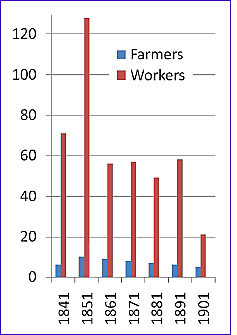
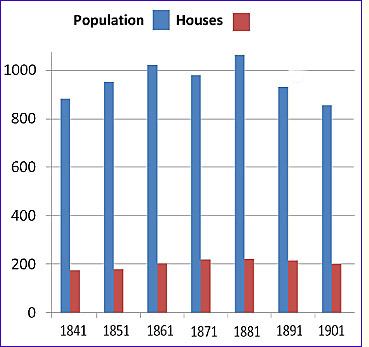
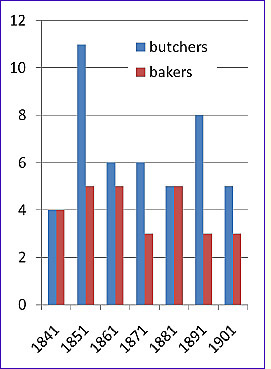
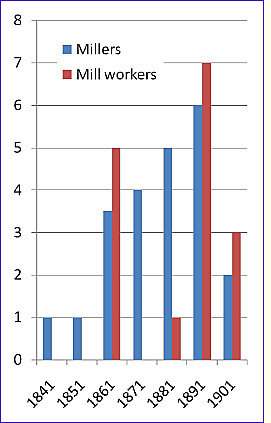
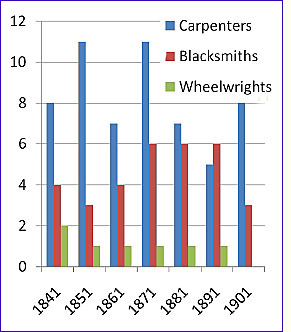 Carpenters, Wheelwrights and Blacksmiths
Carpenters, Wheelwrights and Blacksmiths